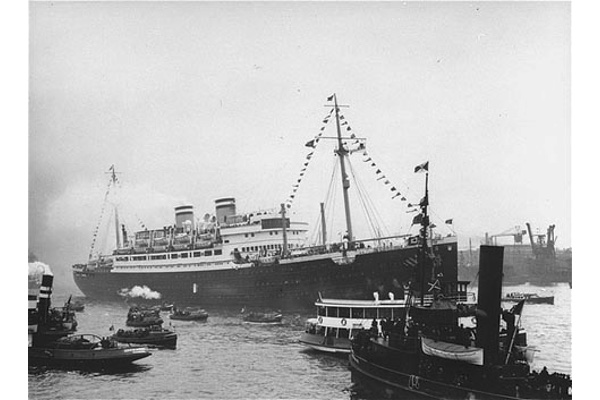The Shocking Cynicism Behind the Voyage of the “St. Louis” and Its Ship Full of Jewish Refugees from Nazi Germany

SS St. Louis surrounded by smaller vessels in its home port of Hamburg
The current refugee crisis mirrors the divisive political debate over welcoming World War II refugees under Presidents Franklin D. Roosevelt and Harry S. Truman. This series of articles views today’s crisis in the historical perspective of World War II and its aftermath. The series is adapted from the author’s book, Useful Enemies: America’s Open-door Policy for Nazi War Criminals.
 In May l939, six
months after the Nazis celebrated Kristallnacht, the German
transatlantic liner St.
Louis steamed
down the Elbe River into the North Atlantic. It would soon become
the symbol of American heartlessness, xenophobia, and anti-Semitism.
In May l939, six
months after the Nazis celebrated Kristallnacht, the German
transatlantic liner St.
Louis steamed
down the Elbe River into the North Atlantic. It would soon become
the symbol of American heartlessness, xenophobia, and anti-Semitism.
Flags were flapping in the wind and well-wishers waved from the Hamburg pier. On board the eight-deck ship were 938 paying passengers, all but one of whom were Jews fleeing Germany for their lives. They had all purchased landing permits from the Cuban government. Several passengers had relatives, spouses, or children waiting for them in Havana. Most were on the waiting list for visas to the United States and planned to stay in Cuba until America granted them entry.
The voyage turned out to be a cruel set-up. Cuba had no intention of letting any passengers off the ship. Caving in to anti-Semitic pressure, Cuban president Federico Laredo Bru had signed “Decree 938” eight days before the ship departed Germany. The decree invalidated the landing permits. No one had told the passengers.
It was more than hiding the truth. The Reich was playing an espionage game and the St. Louis passengers were its pawns. Havana, after all, was the center of German intelligence and espionage activity directed against the United States—a city where Nazi intelligence officers had purchased top-secret documents detailing U.S. submarine designs. The method for smuggling these plans back into Germany was simple: a Nazi agent, planted as a St. Louis crewman, would disembark in Havana, rendezvous with a Nazi intelligence agent there, carry the documents back to the ship, and deliver them to Berlin as soon as the St. Louis returned to Hamburg with its Jewish cargo intact.
Over and above the documents payoff was the negative PR potential. Nazi propaganda minster Joseph Goebbels couldn’t pass up the opportunity to make the United States look like a hypocrite in the eyes of the world. The St. Louis would at once show the German people that the Reich was serious about ridding the country of its Jews and would demonstrate to the world that the Reich was allowing its Jews to leave freely and unharmed. Finally, it would make concrete in human terms what Evian had told the world in theoretical terms: Nobody, especially the United States, was willing to take German and Austrian Jews.
To make sure Cuban president Bru would not change his mind under pressure from the United States and the world community, Goebbels sent fourteen Nazi propagandists to Cuba to stoke the smoldering flames of anti-Semitism. The strategy worked. Five days before the St. Louis steamed out of Hamburg harbor, the streets of Havana boiled over with forty thousand angry demonstrators, the largest anti-Semitic demonstration in Cuban history.
The Hamburg-Amerika line, operating under the direction of the Reich, had chosen Gustav Schroeder, an experienced seaman and staunch anti-Nazi, to captain the St. Louis. While the Reich didn’t trust him, Schroeder was perfect window dressing for their charade.
The St. Louis reached Cuban territorial waters in mid-May. To the shock and anger of Captain Schroeder and its passengers, Cuba refused to allow passengers to disembark until a sales transaction was completed. President Bru put a price of five hundred dollars on the head of each passenger. The bill came to about half a million dollars (nearly $8 million today). It was a bluff. Bru knew the passengers didn’t have that kind of money, and he gambled on the assumption that no one else would come to their rescue. The moment an international coalition of Jewish and non- Jewish leaders called his bluff and deposited the money in the Chase National Bank of Cuba, Bru raised the ante to $650 per head. When an international negotiator tried to bargain with him, Bru abruptly removed his offer from the table.
President Bru’s denial of entry left Captain Schroeder with two choices: return to Hamburg as ordered by the Hamburg-Amerika line or find another country willing to accept more than nine hundred Jewish refugees. Gambling on the generosity of America, Schroeder sailed north into international waters off the coast of Miami and aimlessly cruised up and down waiting for either a change of heart from Bru or a message of welcome from the United States. From the decks of the wandering ship, passengers could see blinking lights of hope from the luxury hotels lining Miami’s beaches. A U.S. Coast Guard cutter shadowed the ship, not so much to prevent it from docking as to “rescue” any passengers desperate enough to try to swim to freedom, and to keep the ship in sight in case President Bru had a change of heart.
Captain Schroeder sent a message to Roosevelt. He didn’t answer. The St Louis’s children cabled a plea for help to First Lady Eleanor Roosevelt. She didn’t answer either.
President Roosevelt’s hands were not completely tied. Although U.S. immigration law prevented the St. Louis passengers from entering the country, he could have issued an executive order to accept them, arguably a politically dangerous move for a sitting president up for re-election. Such an order would also be unfair to the 2,500 Jews already waiting in Cuba for visas, as well as to the many more thousands in Europe who stood in line ahead of the St. Louis passengers. It would have triggered a wave of protest from the anti-immigrant lobby and encouraged the other ships filled with Jews roaming the seas in search of a home to head for the United States.
To complicate the issue even more, the U.S. unemployment rate was still over 17 percent and national feelings of isolationism and anti-Semitism had not changed since the conference at Evian the previous year. Courage aside, Roosevelt was not prone to commit political suicide.
The State Department visa division didn’t keep Captain Schroeder waiting very long. “The German refugees,” it ruled, “must wait their turn before they may be admissible to the United States.” And immigration officials in Miami cabled the following blunt message to the German captain: “The St. Louis will not be allowed to dock here, or at any U.S. port.” To further encourage the problem to go away, the United States offered the ship no water, food, or fuel.
The international press followed the St. Louis story with great sympathy, as Goebbels had hoped. The United States was no better than Nazi Germany, they wrote. It didn’t want German and Austrian Jews either. As the St. Louis pointed its bow back toward Germany and the lights of Miami faded like a dream, hope turned to despair. The passengers cabled President Roosevelt one last plea: “Repeating urgent appeal for help for passengers of the St. Louis. Help them, Mr. President.” Again, there was no response.
The passengers now knew with awful certainty that a return to Hamburg would be a death sentence. Fearing mass suicides, Captain Schroeder set up suicide watch patrols. Then, in a desperate attempt to save themselves, a small group of refugees forcibly commandeered the ship. Schroeder talked them out of their futile mutiny and never pressed charges.
After Canada and Great Britain also refused entry and the other European countries did not volunteer to accept any of the refugees, Captain Schroeder devised plan B. He would shipwreck the St. Louis off the coast of England and set the vessel on fire. Under international law, Great Britain would then be forced to accept the refugees as shipwrecked passengers. Luckily, however, the plan never came to fruition. Before Schroeder could execute it, Great Britain, Belgium, Holland, and France agreed to divide up the passengers.
The voyage of the St. Louis was an espionage and public relations success for the Reich. As for Captain Schroeder, the Federal Republic of Germany awarded him its Order of Merit medal after the war, and Israel posthumously honored him as a Righteous Among the Nations. But 254 of the St. Louis Jews hiding in Belgium, Holland, and France weren’t so lucky. They were murdered in the Holocaust, most in the killing camps of Auschwitz and Sobibor.
The Evian Conference and the St. Louis affair firmly established the first two planks in U.S. refugee policy. First, the United States did not want European refugees, especially Jews. Second, if it had to accept some refugees under its strict quota system to save face, it would make it as difficult as possible for Jews to enter the country even if denial meant death. And if a few thousand Nazi collaborators ended up in the U.S. refugee potpourri, better them than Jews, who belonged in Palestine.